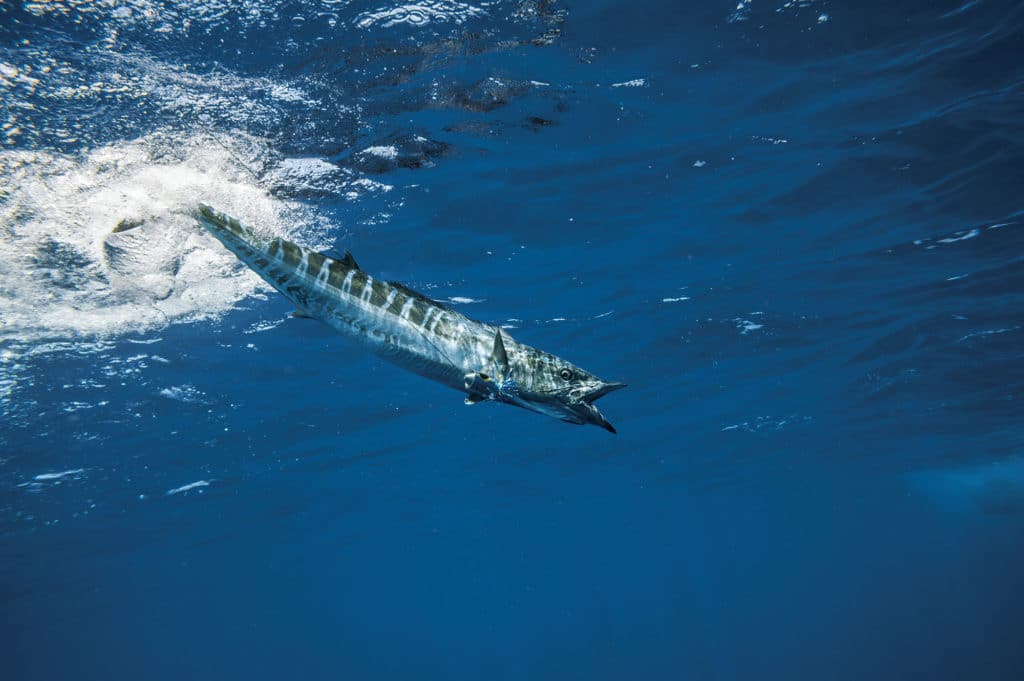
The South Florida seas had grown into nasty 4- to 5-footers; the sky darkened. If it hadn’t been the August full-moon period, Capt. Chris Fay would not have ventured offshore. But he and his buddy were confident that it was prime time to catch a wahoo. “It was rough…nasty,” recalls Fay, a Deerfield Beach, Florida, charter captain (poseidontoo.net). “We had been fishing in 300 feet, but we saw a storm coming in, so we went into shallow water, 97 feet.”
Fay continues: “Right before the sun went down, the moon was coming up. As soon as that moon popped, the one fish that we were looking for decided to feed. We were doing a turn, and I looked over at the short planer rod, and that thing just started dumping. The fish made a 350-yard run, and we knew exactly what it was: a big, fat, giant wahoo.”
The fish, which ate a split-tail mullet, came within 15 feet of the boat after that initial run, then took off on another run. The wahoo eventually came close enough for Fay and his friend to sink two or three gaffs into the fish. Then they struggled to lift the wahoo into their boat.
They headed straight for the dock after that, where the wahoo bottomed out a 75-pound scale. “We just said we’re going to call it 80 pounds,” Fay says. “When you go specifically looking for that one bite on that day, there’s no better feeling, especially when you put in the time and effort.”
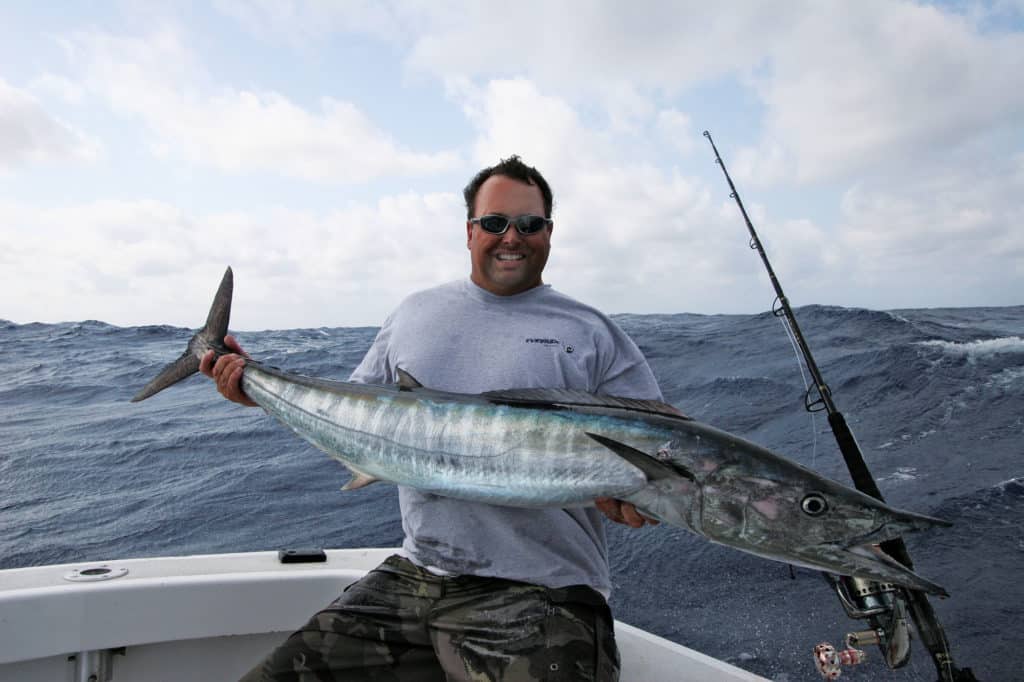
Moon Magic
Anglers catch wahoo year-round throughout southeast Florida, from Jupiter to Miami, yet relatively few know of the hot summertime bite. Savvy anglers and captains like Fay say that the absolute best time to catch the most and biggest wahoo—40 pounds and up—occurs around the full moons in July, August and September.
In the northern Gulf—a well-known action spot for big ’hoos—the prime bite happens in February or March, with no known summer-full-moon bite. In North Carolina, however, a summer fishery ignites a day or two before the full moons of July and August. The fish come in fairly close to shore, says tournament captain Mark Henderson, who caught a 75-pound wahoo in 42 feet of water on a live bluefish two summers ago.
“My favorite moon is in August,” says Fay, who prefers the days leading up to the moon and the day after. “There’s so much more water flooding out of the inlet, and the fish are waiting for the food (baitfish) to come out. I like to fish 2 miles north and 2 miles south of the inlets.”
Capt. Skip Dana, who charters selectively on his center-console Pop-A-Top out of Pompano Beach, Florida, says that in 2018, the wahoo bite was best around the full moon in September. He prefers to fish “three to four days before a full moon and then a few days after. The day of the full moon is usually slower, with the best bite at midday.”
Even kayak anglers take advantage of the summer-full-moon wahoo bite. “I’ve caught them all the way out from a week before the full moon to a week or a week and a half after,” says Joe Hector (extremekayakfishing.com), who puts on kayak-fishing tournaments out of Pompano Beach. His tournament two years ago around the full moon in August produced eight wahoo, including a 71.9-pounder and two others over 50 pounds.
“To me, August is the prime time to get those monster wahoo,” Hector says.
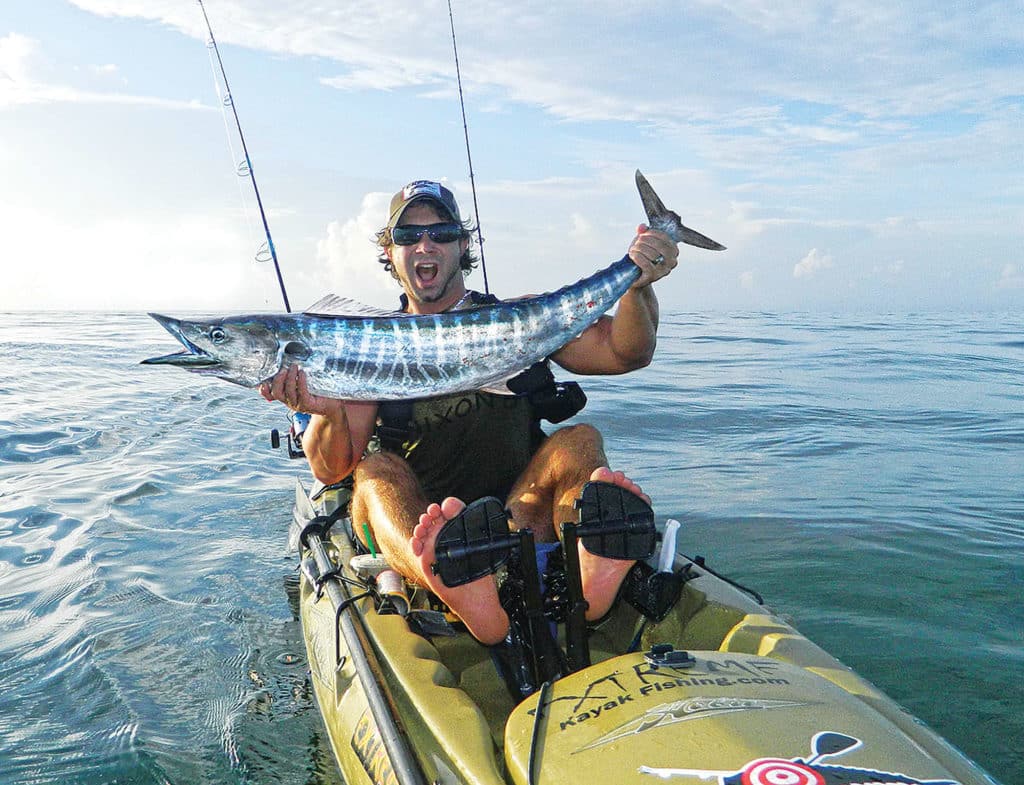
Timing the Tides
Capt. Stan Hunt, who used to charter out of Pompano Beach before retiring and moving up the coast to Palm City, caught one of the region’s most celebrated summertime wahoo several years ago. Fishing in a local tournament, his first fish of the day was a 74.2-pound ‘hoo that he caught trolling in 95 feet of water off Hillsboro Inlet. The biggest fish of the event, that wahoo helped Hunt and his crew to a victory—and a record $99,025 payday.
Where Hunt chooses to fish depends on what the tide is doing because that determines where the bait will be. On the last of an incoming tide, baitfish are pushed close to an inlet, so Hunt fishes shallow. When the tide is out, he fishes around wrecks and other baitfish attractors in 200 to 400 feet of water.
Fay says his favorite tide time to fish for wahoo falls on what he calls the switch of the tides: the first hour of the outgoing and the first hour of the incoming.
“I usually catch wahoo on an outgoing tide,” Hector says. “I fish around the deep wrecks and inlets because that’s when the bait is coming out.”
Fay also likes to fish around wrecks, particularly in depths ranging from 140 to 240 feet. He also studies his depth recorder to locate schools of fish on which wahoo feed. “Get your electronics dialed in to where you can mark the bonitos,” he says. “Where there’s bullet bonitos (tuna) and little blackfin tuna, there’s going to be wahoo. If there are tunas in 400 or 500 feet, guess where the wahoo are?”
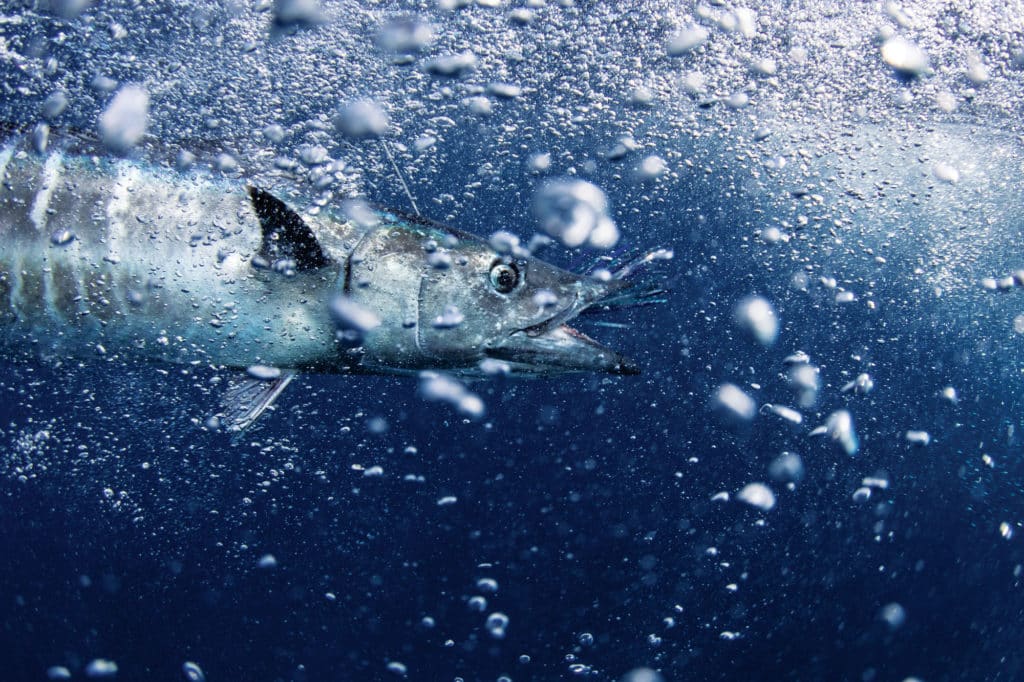
Trolling Tactics
Fay usually fishes a split-tail mullet from a planer 100 feet behind the boat. If he wants the bait deeper, he lets out more line. He also fishes big swimming mullet on two shorter planer lines, each about 20 feet behind the boat.
“There are two kinds of wahoo,” he says. “The shy wahoo that’s going to swim up to the bait three or four times before eating it on the long planer, and the big wahoo that’s not afraid to hit the short planer. They’re not swimming up to look at it; they’re swimming up to crush it. Seventy to 80 percent of my bites come on the short planer. They’re nasty, they’re mean, and they come right up in the prop wash.”
His spread also includes two big lures on the short outrigger lines. He likes to fish lures made locally at RJ Boyle Studio, as well as Ilanders with ballyhoo. On the long rigger lines, he trolls two midsize baits such as a Sea Witch with a fresh bonito strip on a long-shank 10/0 or 12/0 hook.
Fay says, on low-light days, he uses bright colors such as pink-and-blue and chartreuse-and-purple. On bright days and in clear water, he likes blue-and-white, all white and pink-and-white. “In August, my spread is almost all pink. Why? Because shrimp and squid are around on that moon.”
Hunt trolls bonito strips behind Sea Witches or ballyhoo with a skirt; he ties both rigs himself. Both the lures and skirts feature lots of Mylar for added flash, and his favorite skirt color is blue-and-white. He rigs the baits with a single hook, and pulls two of them on planers from the cockpit and one on a weighted line from the bridge at 8 to 9 knots.
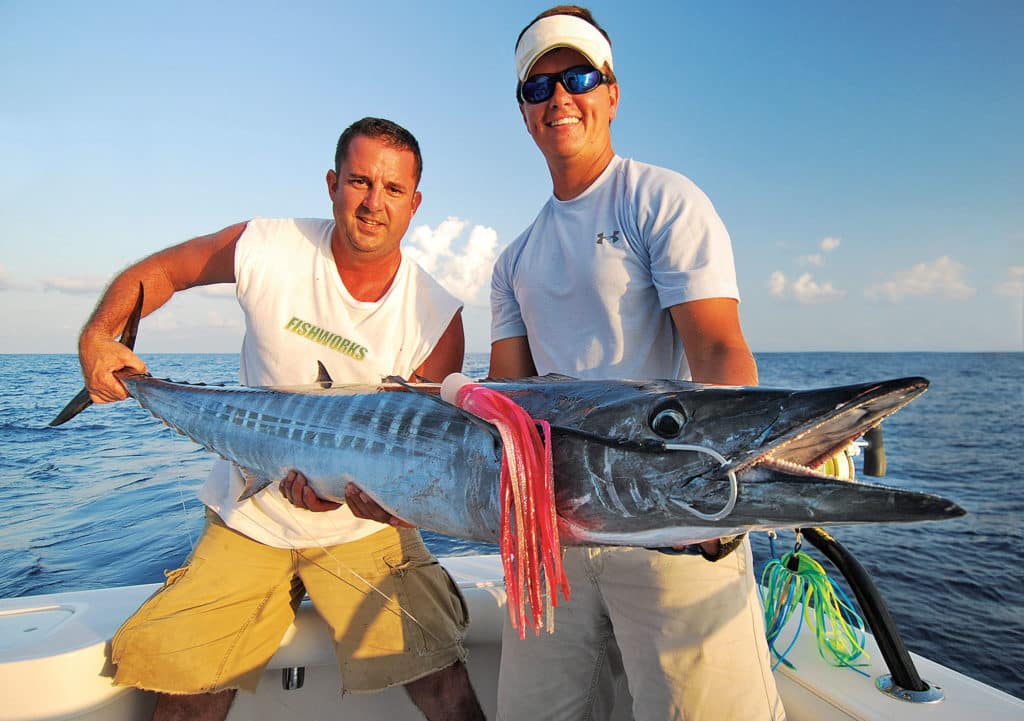
Live-Baiting Choices
Dana prefers to use live bait for summertime full-moon wahoo, especially in August and September. “You get more bites live-bait fishing than any other time of year. I’d rather catch one on live bait than 10 trolling a lure on a planer.
“Usually first thing in the morning, if there’s a little bit of a breeze, I’ll put out the normal spread and try to get surface bites,” says Dana, who’ll fly two fishing kites, each with three lines, a couple of flat lines, and a couple of deep baits. “They’ll sky on the kite baits, just like kingfish.”
Once the sun comes up, he starts slow-trolling in 200 to 400 feet of water. He rigs goggle-eyes, blue runners, speedos and little bullet tuna, and bumps the motors in and out of gear to keep the lines tight. “I’ll put one flat line 200 yards back, and one 50 or 60 yards back. I’ll put a downrigger bait on each side of the boat and stagger them. I’ll start at 75 and 125 feet down, and if I get a bite on the deeper one, I’ll go to 125 and 200 feet.”
When he gets a bite, his crew cranks up the downriggers to get the cables out of the way. Dana also pays attention to the depth where he catches the first wahoo because subsequent bites likely will be in the same depth. And don’t be surprised if you catch other species with downriggers, fishing deeper.
“There are 30- to 40-pound kingfish out there, and sailfish,” he explains. “I don’t know how many times the line takes off, zipping across the surface, and then a sailfish comes up jumping, and I thought I had a wahoo on.”
Hector buys live bait before he launches his Hobie pedal-drive kayak off the beach. He typically buys only five goggle-eyes and three pilchards, and keeps them in a 5-gallon bucket with a battery-powered aerator. Once he catches a wahoo—his personal best is a 65-pounder—he heads back to shore.
“When I’m targeting wahoo, my trips are short and sweet,” he says. “I’ll put out my first gog on the way out in 80 feet, then set up a drift. Or if the current isn’t strong, I’ll slow-troll [by pedaling the kayak]. I free-line a pilchard around 60 yards behind me on top, with a gog below. With goggle-eyes, sometimes to get them down I use a 2- or 3-ounce egg weight and try to keep it at middepth. If you put out two gogs together, you’re going to end up with a tangled mess.
“Believe it or not, I’ve caught more wahoo on big pilchards than on gogs. Some of my best catches have been on a 6-inch pilchard as opposed to a 3- or 4-inch one.”
Hector uses a Garmin Striker depth finder to locate wrecks in 180 to 250 feet, and keeps zigzagging in and out of those depths unless he sees a sizable school of bonito or a solid color change, where the water abruptly changes from greenish to dark blue.
If he catches a blackfin tuna, Hector uses it to entice a wahoo bite. “I’ll cut open the tuna, take my gog or pilchard and stick it in the belly of the tuna, count to three, then put out the bait,” he says. “I believe it’s all about scent. Blackfin tuna and bonito have a distinct scent, and they’re very oily. I believe that’s why wahoo eat them. I once caught three wahoo in three days doing that.”
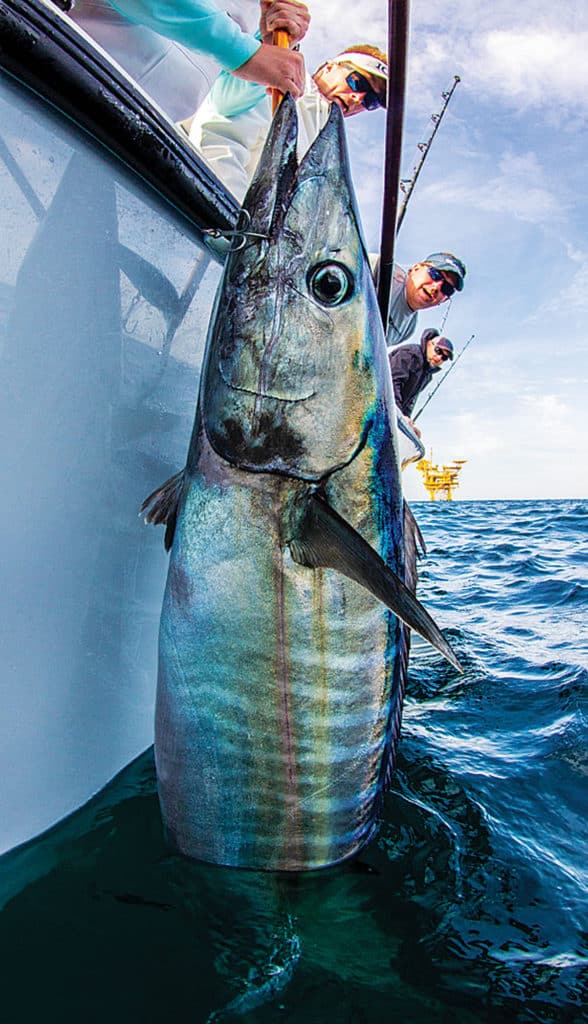
Waging War
Fay fishes his dead baits and skirted strips from a straight-butt rod with a Shimano Tiagra 30-wide reel spooled with 80-pound braided line. He uses a No. 6 or No. 8 planer and trolls at 6 to 7 knots. On calm days, Fay switches to a No. 4 planer and troll at 8 knots.
He connects the other end of the planer to 60 feet of 50- or 60-pound monofilament, attached with a double uni-knot to 10 to 15 feet of 60- to 80-pound fluorocarbon leader. Fay adds 18 to 24 inches of No. 7 wire leader to the fluorocarbon with a Spro swivel.
Dana fishes live baits on Penn Fathom high-speed reels spooled with 20-pound Momoi Orange Crush monofilament line on 7-foot medium-action 20-pound rods. He uses a 15-foot Momoi 30-pound fluorocarbon leader that he ties to the main line with a blood knot. To prevent cutoffs, he adds a 3-foot piece of 30-pound Knot 2 Kinky nickel-titanium leader wire attached to the fluorocarbon with an 80-pound Spro swivel. He ties the terminal end of the leader to a 6/0 VMC J hook, and adds a second J hook as a stinger.
“We always have a stinger on,” Dana says. “The length depends on the size of bait: 3 to 6 inches of No. 6 wire tied to a 4/0 VMC that we hook in the skin just enough so it holds.”
From his kayak, Hector fishes a Shimano 6500 spinning reel spooled with at least 300 yards of 30-pound monofilament on a medium-heavy rod. “In South Florida, you never know what you’re going to get—maybe a yellowfin tuna or a marlin, so you don’t want to miss the opportunities if you get them.”
His leader consists of 50-pound fluorocarbon or monofilament with a 6- or 7-inch piece of 30- or 40-pound wire. He fishes his baits on a 3/0 or 4/0 J hook with a 2/0 treble stinger hook. “Every single wahoo I’ve ever caught, when I gaffed it and brought it in the kayak, was caught in the throat, eye or side by the stinger. The lead hook was swinging freely.”
Read Next: Wahoo: Speeding Up Fast Tactics
Hector ties all of his connections and keeps plenty of spare leaders in a small plastic bag. “I don’t do any swivels,” he says. “When I’m offshore in the kayak, I don’t want to be tying knots the whole time. If my wire gets kinked, I can tie on another leader [with an Albright knot].”
For anglers who have always wanted to catch a big wahoo, timing is everything, and there’s no need to brave wild winter weather to land that trophy fish—at least in South Florida. Check your calendar for the summertime full moons, put out your live bait or trolling lures, and get ready for that sizzling run.
The Kayak Endgame
Kayak angler Joe Hector always keeps a 2-foot gaff with him. He brings the wahoo alongside his Hobie, puts the gaff under the fish, and pulls up rather than reaching out and over the wahoo.
“A lot of anglers have lost some epic fish in our tournaments that way,” he says. “In a kayak, you’re literally in the water with the fish. Just gently put that gaff in the water, and pull up and hold on tight.”
Hector keeps a fish bag aboard; after he gaffs the wahoo, he puts it into the bag headfirst. “You don’t want him coming out of the bag headfirst,” he says. “The good thing about wahoo, most of the time—especially with big ones—is that by the time you get them up to the kayak, they’re close to death.”








